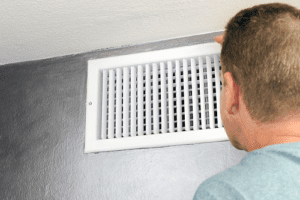Every homeowner has firsthand experience with HVAC systems. While many homes don’t have central AC, every modern home has central heating of some kind, whether it’s electric, gas, oil, geothermal, heat pump, or less common heating methods. Today, we’re going to consider the ten key features of HVAC systems so that you can understand what’s involved in each of them, and what parts may need maintenance as you keep your home in good condition.
The Key Features of HVAC Systems Installed in the Home
 Air conditioners and heaters are complicated systems, and a lot goes into planning out a new installation. Here’s our list of the key features of HVAC systems like those in your home:
Air conditioners and heaters are complicated systems, and a lot goes into planning out a new installation. Here’s our list of the key features of HVAC systems like those in your home:
- Thermostat – Modern systems have advanced thermostats that give you exceptional control over what the system does for you. When used correctly, the thermostat can reduce your heating and cooling costs by decreasing system operation at night or when your home is unoccupied. When your family is at home, then an automated thermostat can return the temperature to its ideal setting. Even without an advanced automatic unit, you can still manually adjust the temperature, but make sure not to forget to set it back when you wake up.
- Fuel Source – Most heaters will rely on electricity, gas, or home heating oil to produce heat, while air conditioners will usually depend on electricity to function. In some cases, your system may connect to geothermal energy sources that use a lake or other temperature reservoir to control the temperature in your home.
- Distribution System – Whether your system uses a furnace to heat air or to heat water that gets piped throughout your home, it relies on some method of taking the heat from your fuel source and getting it to the rooms that need additional heating. The way your system gets that heat around will determine whether the output is a dry heat, if it heats your home quickly, or if it takes a while before changes to the thermostat result in changes to the temperature in your home.
- Electrical Components – These components must work properly to ensure that your system functions. The wiring that goes from your thermostat to the central unit, the connections within the central unit, and the control over your fuel source all play a major role in your system’s functionality.

- Ductwork – Ducted systems rely on this network of metal tunnels to travel throughout your home and deliver heated or cooled air. As the air passes through these ducts, dust, mold, and other particulates can accumulate in the ducts. Every year or two, you should clean your ducts so that the air is as fresh as possible in your home.
- Filters – Your system likely has filters both at the system intake and any return registers. These registers may be in different locations throughout your home, but they’re connected to your ductwork and return air from your heated or cooled rooms. As the air returns to your central heater or air conditioner, it must be filtered so that you don’t lose air quality over time. Make sure that you change these filters every month or two so that the air flows freely and cleanly throughout your home.
- Refrigerant – Your air conditioner depends on a refrigerant, often freon, to cool the air. If your refrigerant ever leaks, you’ll quickly find that it fails to bring the temperature down to the desired level. In that case, you’ll need to bring a contractor out to refill the machine.
- Location of Outdoor Unit – Your outdoor unit must be connected by wiring and pipes so that it can condense the external air, release heated air, and send the cooled refrigerant back into your home. Generally, the unit should be close to your internal unit to minimize the amount of infrastructure needed to connect the two parts.
- Location of Indoor Unit – Many homes put their indoor units in the basement, close to a rear exit if the home has one. This location is ideal, as it allows both internal and external units to be close to each other and ensures that HVAC technicians can access the system any time they need to work on it for routine maintenance.
- Efficiency – While not a component of the system, your HVAC’s efficiency is a telltale sign of how well it’s working. If you notice any changes to your system’s functioning, that could be a sign that it’s not working correctly and is due for maintenance. Keep an eye on your power bill to see if it ever has unexpected fluctuations that aren’t justified by the external temperature.
Using the Key Features of HVAC Systems for Better Maintenance
We recommend taking the time to examine your system and learn where each of these key features of HVAC systems is in your home. The next time you schedule maintenance from your trusted HVAC contractor, ask them to give you the detailed tour of your system so that you can find all the filters, air registers, and internal components. With a little more familiarity, you can identify where issues are likely to arise and schedule maintenance calls exactly when you need them.
